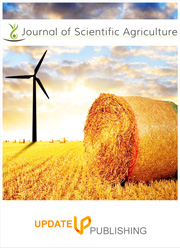Quantification of sericin extracted from different seri bio-waste sources
DOI:
https://doi.org/10.25081/jsa.2025.v9.9502Keywords:
Sericin extraction, Floss, Deformed cocoons, Hydrothermal processing, Value-additionAbstract
Apart from good quality cocoons, the cocoon crop generates defective cocoons viz., double cocoons, stained cocoons, deformed cocoons, thin end cocoon, cut cocoon, flimsy cocoon, etc., which are non-reliable. Since many cocoons which do not adhere to quality are wasted in this activity, one of the foremost and convenient options is the extraction of sericin from waste cocoons. Sericin is a globular protein possessing promising attributes such as, antioxidant activity, antimicrobial activity, easy absorption and release of moisture, coagulant activity, chemo-protection and protection of solar ultraviolet (UV) radiations. The deformed cocoons, stained cocoons, undersized cocoons and silk floss were used to extract sericin via., hydrothermal degumming using an autoclave. Significantly, the higher quantity of sericin (18.38%) was obtained from deformed cocoons followed by stained cocoons (17.26%), undersized cocoons (15.04%) and floss (13.84%). Following the protocol developed for the extraction of sericin, it is estimated that in J&K, 22.34 MT of sericin could be extracted annually that can contribute to value addition in sericulture.
Downloads
References
Al Masud, M. A., Shaikh, H., Alam, M. S., Karim, M. M., Momin, M. A., Islam, M. A., & Khan, G. M. A. (2021). Green synthesis of silk sericin-embedded silver nanoparticles and their antibacterial application against multidrug-resistant pathogens. Journal of Genetic Engineering and Biotechnology, 19(1), 74. https://doi.org/10.1186/s43141-021-00176-5
Aramwit, P., Kanokpanont, S., Nakpheng, T., & Srichana, T. (2010). The effect of sericin from various extraction methods on cell viability and collagen production. International Journal of Molecular Sciences, 11(5), 2200-2211. https://doi.org/10.3390/ijms11052200
Bharathi, M. C., Umakanth, R. S., & Ashoka, K. S. (2020). Extraction of sericin from cocoon shell and raw silk of bivoltine and multivoltine breeds of the Silkworm, Bombyx mori L. Journal of Entomology and Zoology Studies, 8(4), 869-871.
Capar, G., & Aygun, S. S. (2015). Characterization of sericin protein recovered from silk wastewaters. Turkish Bulletin of Hygiene and Experimental Biology, 72(3), 219-234. https://doi.org/10.5505/TurkHijyen.2015.47113
Cherdchom, S., Sereemaspun, A., & Aramwit, P. (2021). Urea-extracted sericin is potentially better than Kojic acid in the inhibition of melanogenesis through increased reactive oxygen species generation. Journal of Traditional and Complementary Medicine, 11(6), 570-580. https://doi.org/10.1016/j.jtcme.2021.06.005
Ghosh, S., Rao, R. S., Nambiar, K. S., Haragannavar, V. C., Augustine, D., & Soumya, S. V. (2017). Sericin, a dietary additive: Mini review. Journal of Medicine, Radiology, Pathology and Surgery, 4(2), 13-17.
Gupta, D., Agrawal, A., & Rangi, A. (2014). Extraction and characterization of silk sericin. Indian Journal of Fibre & Textile Research, 39, 364-372.
Jena, K., Pandey, J. P., Kumari, R., Sinha, A. K., Gupta, V. P., & Singh, G. P. (2018). Tasar silk fiber waste sericin: New source for anti-elastase, anti-tyrosinase and anti-oxidant compounds. International Journal of Biological Macromolecules, 114, 1102-1108. https://doi.org/10.1016/j.ijbiomac.2018.03.058
Qadir, J., Gupta, R. K., Bali, K., Sharma, M., & Gupta, S. K. (2022). Impact of sericin fortified leaves on the cocoon traits of Silkworm Bombyx mori L. The Pharma Innovation, 11(10), 1519-1522.
Rajput, S. K., & Singh, M. K. (2015). Sericin - A Unique Biomaterial. IOSR Journal of Polymer and Textile Engineering, 2(3), 29-35.
Reddy, R. M. (2008). Value addition span of silkworm cocoon - Time for utility optimization. International Journal of Industrial Entomology and Biomaterials, 17(1), 109-113.
Saha, J., Mondal, M. I. H., Sheikh, M. R. K., & Habib, M. A. (2019). Extraction, structural and functional properties of silk sericin biopolymer from Bombyx mori silk cocoon waste. Journal of Textile Science & Engineering, 9(1), 1000390. https://doi.org/10.4172/2165-8064.1000390
Wang, W.-H., Lin, W.-S., Shih, C.-H., Chen, C.-Y., Kuo, S.-H., Li, W.-L., & Lin, Y.-S. (2021). Functionality of silk cocoon (Bombyx mori L.) sericin extracts obtained through high-temperature hydrothermal method. Materials, 14(18), 5314. https://doi.org/10.3390/ma14185314
Published
How to Cite
Issue
Section
Copyright (c) 2025 Jasmeena Qadir, Tajamul Islam, Rakesh Kumar Gupta, Kamlesh Bali, Magdeshwar Sharma, S. K. Gupta, R. K. Samnotra

This work is licensed under a Creative Commons Attribution-NonCommercial-NoDerivatives 4.0 International License.



 .
.